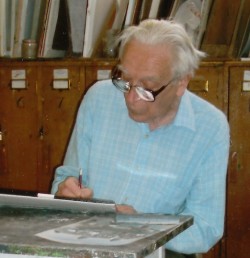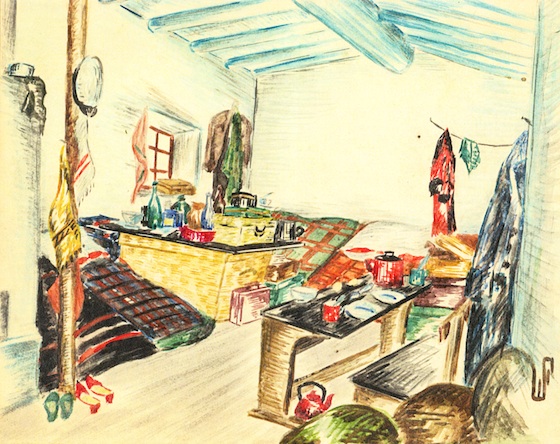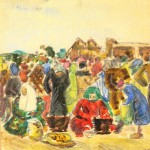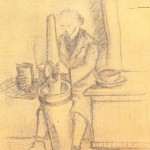- Stay Connected
 Abraham Lincoln
If given the truth, the people can be depended upon to meet any national crisis...
Abraham Lincoln
If given the truth, the people can be depended upon to meet any national crisis...
 Guildford news...
for Guildford people, brought to you by Guildford reporters - Guildford's own news service
Guildford news...
for Guildford people, brought to you by Guildford reporters - Guildford's own news service
Our Modest Local Artist Who Has An Epic Story
Published on: 9 Mar, 2012
Updated on: 31 Aug, 2015
The man behind the exhibition ‘Glimpses of Guildford‘ (10-24 Mar Guildford House Gallery), Boris Fijalkowski, a modest man, is a valued local artist who has contributed significantly to our local culture and the artistic record of Guildford. However, there is more to Boris than his beautiful etchings and water colours. His experiences during the Second World War are truly epic and would make a fascinating book in their own right.
Auriol Earle, who came up with the idea for the exhibition, interviewed Boris and wrote this article (previously published in the Guildford Society’s Newsletter), which includes a snapshot of his wartime adventures…
The idea for this exhibition arose when a small group of Guildford Society members had gathered to try to select a retirement present for John Baylis on his retirement from the Chair of The Society.
John had served the Society so expertly, and for so long that members wished to mark his contribution in a personal way. He was known to admire Fijalkowski’s work and Boris had nobly brought portfolios and sketch-books, and the contents were spread all over our dining room table. There were exclamations of “This one is marvellous! ……..this one is even better – look at the accuracy of the drawing! No he must have a water-colour – look how lovely this one is!”
And so on and so on – in the end, unable to decide we rang John to come and choose his own! But we could hardly bear to put the pictures away – an Exhibition was the obvious answer. Timing too was obvious: the town is about to undergo a period of development and change. Many will want a record of how it looks today.
Boris arrived in Guildford in the sixties, and has spent many hours sketching the buildings, and the landscape ever since. He has line drawings illustrating Russell Chamberlin’s book “Guildford, Town Under Siege,” 1987; Guildford Borough Council then made use of his gift: he illustrated their “1990 Local Plan” followed by the Arts and Crafts movement’s “Nature and Tradition” 1993.
His careful draughtsmanship is displayed in the long drawing of the north side of the High St – reproduced at the top of the escalator in Waterstones bookshop. The Society’s “Glimpses of Guildford” is entirely devoted to Boris’s drawings and pen-and-wash work; and, he won the competition to design our popular and well known logo – which is still in use.
Boris, was born in 1924 and came to England from Lwow in his native Poland, by a circuitous journey which started as a teenager at 3 a.m. one morning in April 1940. The family were woken by kicking and banging on the door and armed Russian soldiers broke in to take him and his mother to a train, load them with hundreds of others into trucks and carry them on a terrifying, life-threatening journey, to they knew not where.

Map, drawn by Boris, showing his escape route from Siberia to Tehran where he joined the Free Polish Army.
It was a journey which took them by various means of transport 5,600km over mountains and across deserts to Bukon in Kazakhstan, in western Siberia. In two years of forced labour in extreme conditions of heat and cold, on various farming, irrigation and building projects, there was little to eat or drink and survival was a struggle.
By now the Germans, who had invaded Russia in July 1941 by December had almost reached Moscow and Stalin, desperate for help allowed the formation of a Polish Army. Thousands of refugees were arriving from all over Siberia to join up and in the ensuing chaos Boris and his mother managed to travel the 1800 km to Tashkent and thence to Teheran where the Polish Army linked up with the British Eighth Army.

Boris, an officer in a Polish signals unit, with his mother, who worked as a YMCA canteen manageress, during the Italian campaign
Having left Poland as a schoolboy, Boris was now a man – a soldier who took part in the whole Italian campaign including the Battle of Monte Cassino.. After the war ended, he was repatriated to Scotland in 1946 hoping to study Art History finally in 1946 enrolled in the Polish School of Architecture which formed part of the University of London. After qualification he joined the LCC Schools Architects’ Department and when offered a job by Norman & Dawbarn he moved to Surrey, and finally to Guildford where he and his family have lived happily for 51 years.
As a child, Boris was happiest when sketching and even in Mongolia he recorded the nature of the landscape and the dress and activities of its people and the nature of their homes on any scraps of paper he could find. Sad to say, much of this early work was confiscated by suspicious officials at the many frontiers he had to cross during his escape. How fortunate we are that Guildford has inspired such a naturally gifted artist of trained architectural skills to record the charm of the town and its setting in the Surrey Hills. His first exhibition ever is not to be missed!
Article published with the kind permission of Auriol Earle and The Guildford Society. Please click here to see the society’s website. All images by kind permission of Boris Fajilkowski.
- Boris at work on an etching
- Boris at work a few years ago on an etching






















Recent Comments